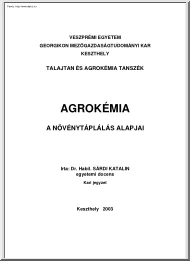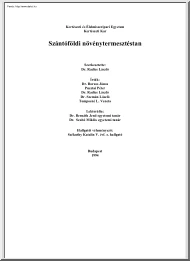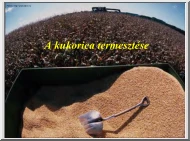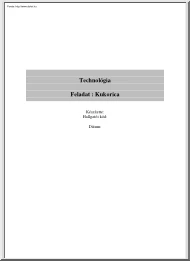Datasheet
Year, pagecount:2003, 2 page(s)
Language:English
Downloads:2
Uploaded:April 23, 2018
Size:677 KB
Institution:
-
Comments:
Attachment:-
Download in PDF:Please log in!
Comments
No comments yet. You can be the first!Most popular documents in this category
Content extract
Source: http://www.doksinet Practical F F T C Technology Postharvest PT2003-02 Processed edible products from wild plants W ILD EDIBLE plants and fruits abound in the northern mountains of the Philippines. During the peak season when the supply of fruits is abundant, many of them simply go to waste. Processing is a good way of making use of these fruits. Some typical products Selling products made from processed wild fruits is a good source of income for housewives, students, outof-school youths, etc. Processed wild foods may help alleviate food shortages and malnutrition. Fig. 1 Sapuan, (also known as degway and chogway) (Sauraria sparsiflora) Taste tests revealed that processed food products made from wild fruits were palatable. The highest net return per kilogram of fresh fruits was obtained from jelly made from the fruits of bisodak (Embelia philippinensis). This gave a net profit of US$070 per kilogram of fresh fruits. This was followed by wine derived from the fruits of
bisodak, sapuan (S. sparsiflora) (Figs. 1 and 2), and bignay (Antidesma bunius) (Figs. 3 and 4) Wine made from these three species gave a return of about US$0.57 per kilogram of fresh fruits. Candies from sapuan came next, giving a net profit of US$0.52 per kilogram of fresh fruit Pickles made from sapuan fruit gave a net return of US$0.40/per kilogram of fresh fruits. Fig. 2 Collected fruit of sapuan This is a medium-sized tree reaching a maximum height of 7-8 meters. It has long, broad leaves The fruit is green when mature, with a sour taste. The fruit is good for jam, candies and pickles Food and Fertilizer Technology Center (FFTC) 14 Wenchow St., Taipei, Taiwan ROC Tel.: (886 2) 2362 6239 Fax: (886 2) 2362 0478 E-mail: fftc@agnet.org Website: wwwfftcagnetorg FFTC: An international information center for small-scale farmers in Asia Cooperating agency for this topic: Philippine Council for Agriculture, Forestry and Natural Resources Research and Development, Los Baños, Laguna,
Philippines 4030 Fax: (63 49) 536 0016 E-mail: pcarrd@dost.govph Source: http://www.doksinet Processing method gives a list of the processed products made from these edible wild plants. Fruits and leaves of some wildfood fruits may be processed into different edible products such as wine, vinegar, candies, and jellies (Figs. 5 and 6) Table 1 Table 1. Processed foods made from wild plants Common name Sapuan, degway, chogway (Fig. 1, Fig 2) Bignay (Fig. 3, Fig 4)) Pinit, boyot (wildberry) (Fig. 5, Fig 6) Bisodak Philippine blueberry Latin name Processed products Sauraria sparsiflora Elm. Dell Jelly, vinegar Antidesma bunius L. Spreng Sacandra glabra Thumb Rubus niveus Thumb Vinegar, wine Tea Candy, wine, vinegar Embelia philippinensis A. DC Vaccinium shitfordii Merr. Wine, jelly Jam, preserves Fig. 5 Pinit, boyot (Wildberry) (Rubus niveus Thumb) This is a plant has a prickly stem that reaches a height of 3-4 meters. The fruits and peeled shoots are both edible The fruit are
smaller than those of the regular strawberry. They can be eaten raw, or can be processed into jam, wine and candy. Fig. 3 Bignay (Antidesma bunius) Bignay is a shrub or small tree. The small green flowers of bignay have no petals (see top photo), and have a slightly offensive smell. The tree is a broadleaved evergreen It bears clusters of small oval or round fruits which are dark purplish to red when they are ripe with a thin, tough skin. Fig. 4 Fruit of Bignay Fig. 6 Wildberries packaged for sale
bisodak, sapuan (S. sparsiflora) (Figs. 1 and 2), and bignay (Antidesma bunius) (Figs. 3 and 4) Wine made from these three species gave a return of about US$0.57 per kilogram of fresh fruits. Candies from sapuan came next, giving a net profit of US$0.52 per kilogram of fresh fruit Pickles made from sapuan fruit gave a net return of US$0.40/per kilogram of fresh fruits. Fig. 2 Collected fruit of sapuan This is a medium-sized tree reaching a maximum height of 7-8 meters. It has long, broad leaves The fruit is green when mature, with a sour taste. The fruit is good for jam, candies and pickles Food and Fertilizer Technology Center (FFTC) 14 Wenchow St., Taipei, Taiwan ROC Tel.: (886 2) 2362 6239 Fax: (886 2) 2362 0478 E-mail: fftc@agnet.org Website: wwwfftcagnetorg FFTC: An international information center for small-scale farmers in Asia Cooperating agency for this topic: Philippine Council for Agriculture, Forestry and Natural Resources Research and Development, Los Baños, Laguna,
Philippines 4030 Fax: (63 49) 536 0016 E-mail: pcarrd@dost.govph Source: http://www.doksinet Processing method gives a list of the processed products made from these edible wild plants. Fruits and leaves of some wildfood fruits may be processed into different edible products such as wine, vinegar, candies, and jellies (Figs. 5 and 6) Table 1 Table 1. Processed foods made from wild plants Common name Sapuan, degway, chogway (Fig. 1, Fig 2) Bignay (Fig. 3, Fig 4)) Pinit, boyot (wildberry) (Fig. 5, Fig 6) Bisodak Philippine blueberry Latin name Processed products Sauraria sparsiflora Elm. Dell Jelly, vinegar Antidesma bunius L. Spreng Sacandra glabra Thumb Rubus niveus Thumb Vinegar, wine Tea Candy, wine, vinegar Embelia philippinensis A. DC Vaccinium shitfordii Merr. Wine, jelly Jam, preserves Fig. 5 Pinit, boyot (Wildberry) (Rubus niveus Thumb) This is a plant has a prickly stem that reaches a height of 3-4 meters. The fruits and peeled shoots are both edible The fruit are
smaller than those of the regular strawberry. They can be eaten raw, or can be processed into jam, wine and candy. Fig. 3 Bignay (Antidesma bunius) Bignay is a shrub or small tree. The small green flowers of bignay have no petals (see top photo), and have a slightly offensive smell. The tree is a broadleaved evergreen It bears clusters of small oval or round fruits which are dark purplish to red when they are ripe with a thin, tough skin. Fig. 4 Fruit of Bignay Fig. 6 Wildberries packaged for sale





 When reading, most of us just let a story wash over us, getting lost in the world of the book rather than paying attention to the individual elements of the plot or writing. However, in English class, our teachers ask us to look at the mechanics of the writing.
When reading, most of us just let a story wash over us, getting lost in the world of the book rather than paying attention to the individual elements of the plot or writing. However, in English class, our teachers ask us to look at the mechanics of the writing.